by Jenny Faulkner
I was born in
one of the prefabs on the Portobello estate during the terrible
winter of 1947/48. The snow was deep on the ground but that
did not stop Nurse Richards coming out to attend the birth. As
she always did, she set out on her bike with her black Gladstone
bag, full of her instruments, in the wicker basket on the front.
But Nurse Richards never was the best of cyclists and, as often
happened, she fell off. The Gladstone bag shot out of the
basket and all the instruments disappeared into the snow drifts.
All the neighbours came out to pick her up and to dive around in the
snow to find the instruments. It took them some while but
eventually Nurse Richards got round to our place in time to act as
midwife to my entry into the world.
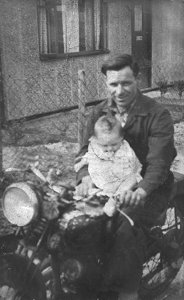 |
This is me, when only a few
months old, sitting with my father on his motorbike.
He was a despatch rider. |
| This photo, taken on the same
occasion, give a better view of the prefabs when they
were new. |
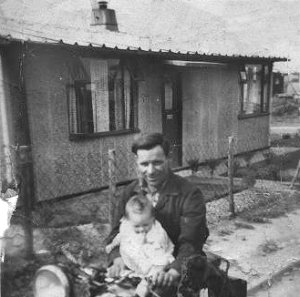 |
The prefab estate at
Portobello had been built just after the war and it was
exclusively for the use of returned servicemen. It fronted
onto Hill Road. All the roads on the estate were named
after great battles of the Second World War: Arnhem Road and
Alamein Drive ran round the estate and Tobruk Walk run up the
middle.
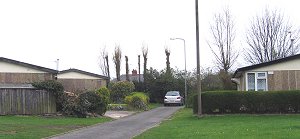 |
The house (seen in 2006) in
which I was born is the one on the right. There
are only two houses on each side now but I remember
there having been three houses each side on every
cul-de-sac. |
Round the
sides, in cul-de-sacs containing six prefabs each, were prefabs with
pebble dash fronts and sides; whilst in the middle were a second
type of prefab with plain fronts and sides. Those of us
who lived in the gravel prefabs rather looked down on the houses of
those who lived in what we called the cardboard prefabs.
| Part of the estate, seen in
2006. Although originally intended to be
temporary, these prefabs have proved to be wonderful -
and long lived - homes. |
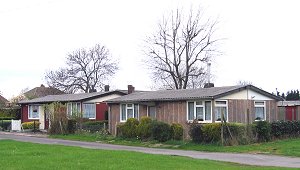 |
But all the
prefabs were very well designed and equipped – we even had a
refrigerator when they were very rarely seen in people’s homes.
And on this estate we had very big back gardens and each one had
been provided with an Andersen shelter to use as a garden shed.
|
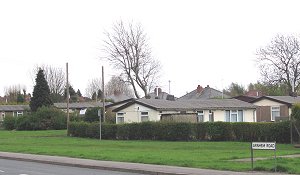 |
Another group of the houses
which are still on the estate. All the remaining
prefabs are of the type with pebble dash walls - though
now a lot of them have been altered a lot. |
One of the
prefabs was set aside as a clinic and there Nurse Richards presided.
And she had plenty to do. With a lot of ex-servicemen around,
all wanting to start families after the war, there were plenty of
kids on the estate. Nurse Richards conducted ante-natal
clinics, acted as midwife, and then weighed, measured, tested the
eyes and generally checked up on the growing children. She
also handed out the orange juice and Virol and cod liver oil which
our parents administered to us each day. The orange juice and
the malt Virol were nice, but the cod liver oil was vile.
| This is the prefab which was
originally Nurse Richards' clinic. As you can see
it is now much altered and is in residential use. |
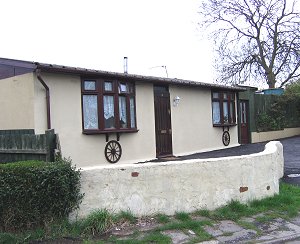 |
Nurse Richards
was also the nit nurse. She did everything else as well but
every child seems to remember her most as the nit nurse. The
nit nurse would come round all the schools in turn to inspect the
children to see if they had head lice and to treat them if they did.
Nurse Richards used to come to my school, Stow Health school, which
had been newly built after the war to take children from the new
local estates. When the nurse arrived she settled into the
school office and then each class was called in turn to line up in
the corridor outside the office. Then each child was called in
and examined and, if they were found to have nits, they were given a
note to take home to their parents. When Nurse Richards
returned next week that child, along with all the others who had had
such a note, were called out of class to go back to the office.
There the nurse would comb their hair with a tooth comb and then
wash their hair with a special soap called Derbac. It was a
kind of amber colour and it smelled like coal tar soap. But
when it was wetted and rubbed onto wet hair it produced a grey-black
foam. The child then had to sit there for about half-an-hour
while it did its work. Then their hair was rinsed and combed and
then they came back to class. You could always tell what had
happened to them because their hair was plastered down and the
distinctive smell of the soap preceded them into the class room.
When one child was found to have nits all their brothers and sisters
at the school were immediately called in and examined because these
things spread by close contact.
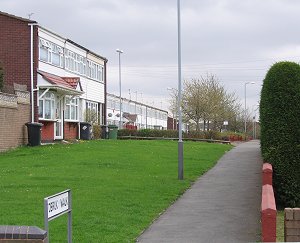 |
Only the prefabs in the cul de
sacs round the edge of the estate survive. Those
in the centre went long ago and have been replaced by
these modern houses. But the name of the road is
Tobruk Walk. |
I am pleased to
say that I never had nits or anything else of the sort. But on
one occasion when, I suppose, Nurse Richards was away, we had a new
nit nurse. I was duly examined by her and given a note.
When I got home my mother found that the note said that I had a
dirty neck and it must be washed before I went to school again!
We were furious, not least because I did not have a dirty neck.
I had a rather dark complexion anyway and I had been out in the sun.
The nurse didn’t seem to know the difference between a sun tan and
dirt!
|
Stow Lawn School today. |
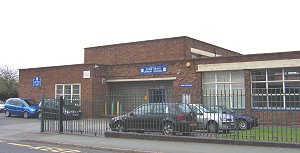 |
But the school
was not just a place for learning the three Rs and attending the nit
nurse. It was one of the important centres of the community.
Every Saturday morning the Head Teacher, Mr. Bailey, would put on a
film show in the school hall which all the kids attended. He
normally showed Norman Wisdom films. I suppose Mr. Bailey
liked them – and so did I. And there would be school trips by
charabanc. Several months in advance of each trip parents were
sent a note about the date of the next trip and were given a card on
which a record of the weekly payment to cover the cost of the trip
could be kept, so that everything was paid for when we set off.
I think we usually went to Rhyl but we always had a great time, even
when it rained!
Nurse Richards
was just as important a part of the community. She was a funny
little woman, short and plump, with her hair parted in the middle
and tied into a bun at the back. She work a black dress with
white lace collar and cuffs, which she would always carefully take
off before getting down to work. When she rode around on her
bicycle for her daily visits as a district nurse she would put on
her cape, which was black with a red lining and which billowed out
behind her. She often fell off, which lead my Father to say “I
wish she could ride a bike as well as her brother could ride an
‘oss”. For the fact of the matter was that her brother was Sir
Gordon Richards, the most famous jockey of the day. When we
kids were playing in the street and saw her coming we would run off
as fast as we could – because, if we didn’t, she would pick out one
of us and say “I am just going to see your mother. Come
along with me”. And then she would take you home, have a chat
with your mother, check that everything was going all right and have
a cup of tea. And when she left your mother would say “What
did you want to bring her home for?”.
Nurse Richards
was still there when I left the estate to get married and I think
she carried on for many years more, still a pillar of the community.
I think she never married or had children of her own. I think
that we were all her children.

|
Return to
the
previous page |